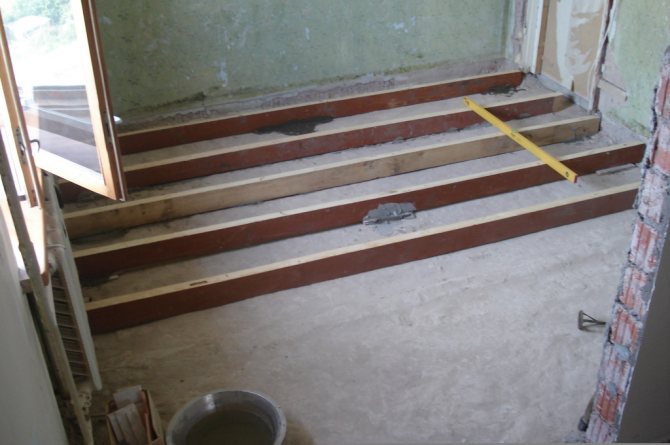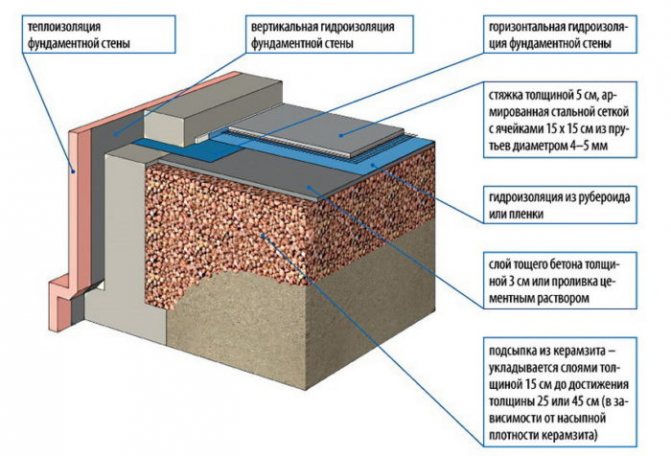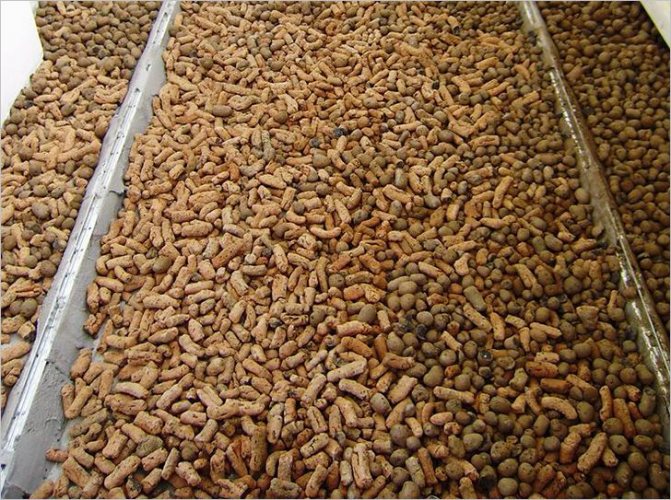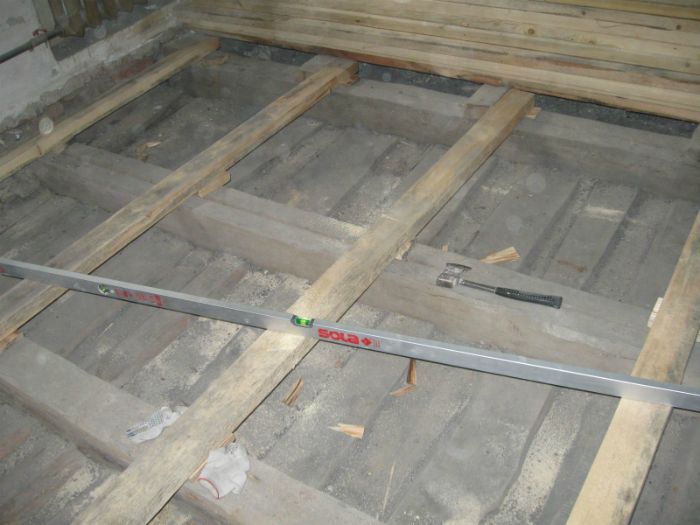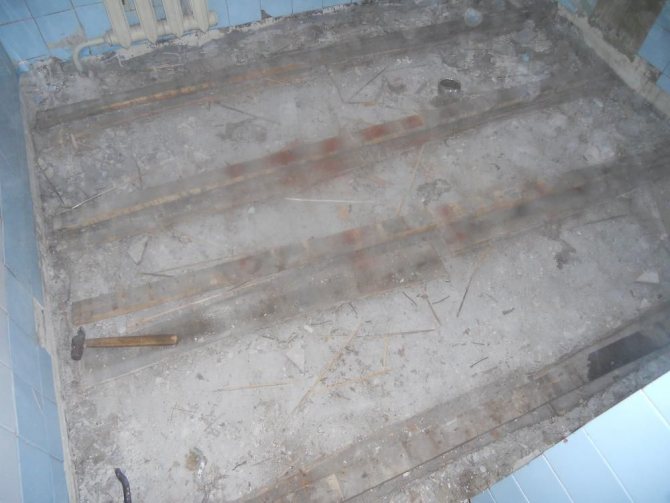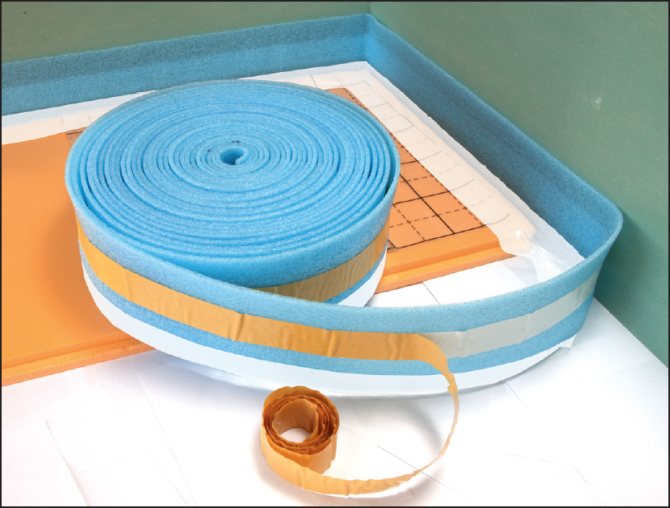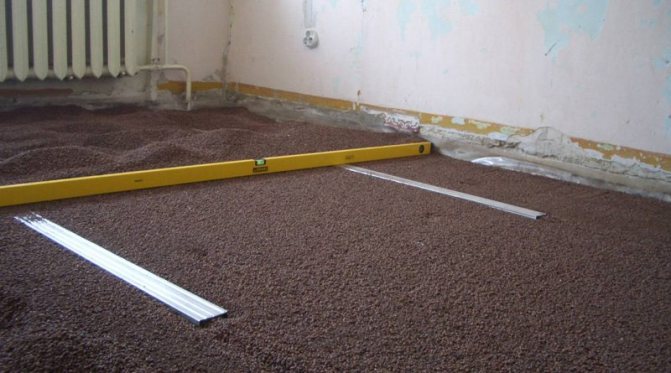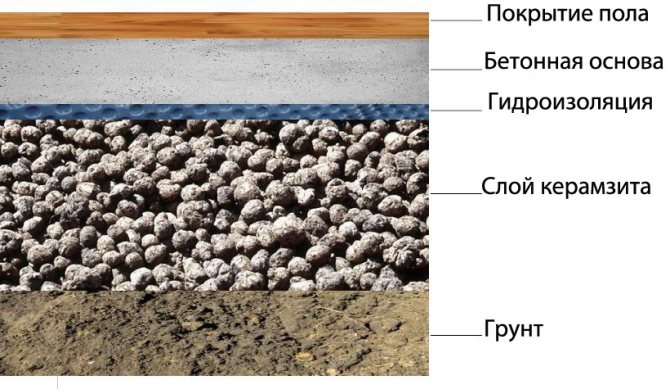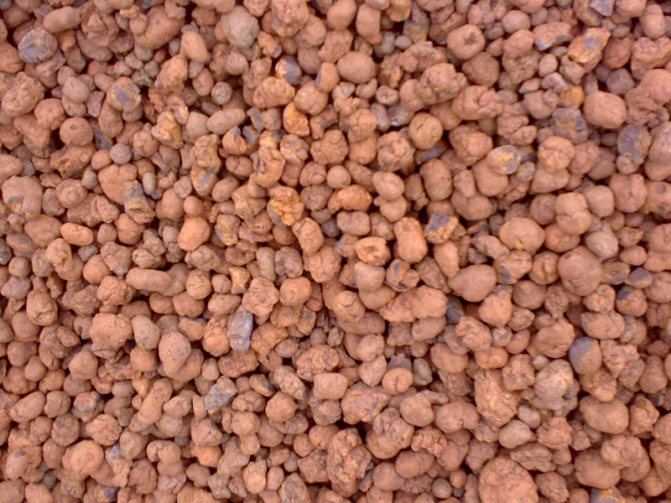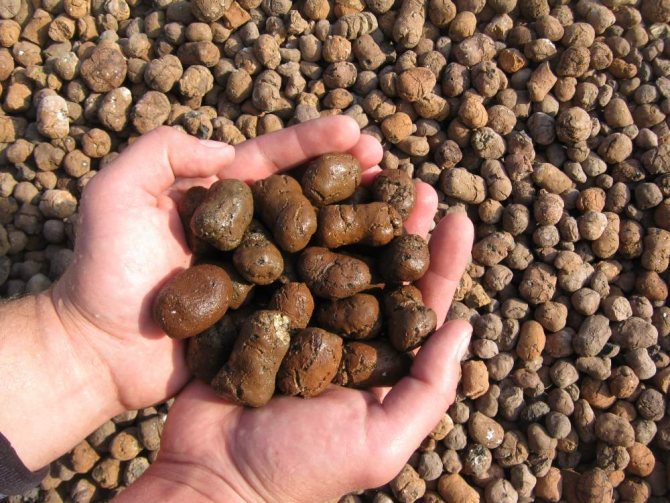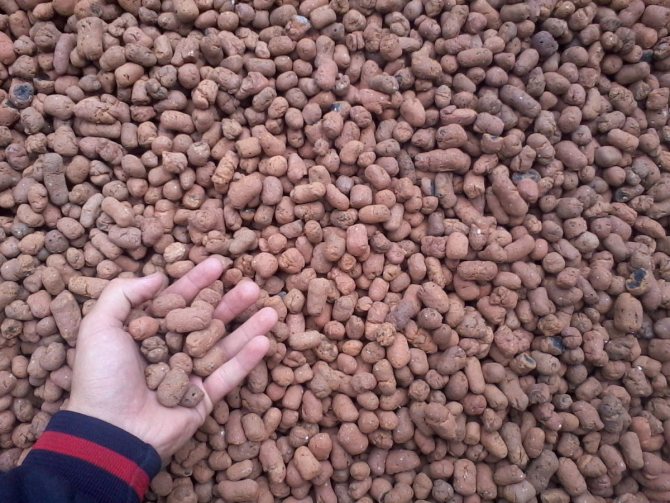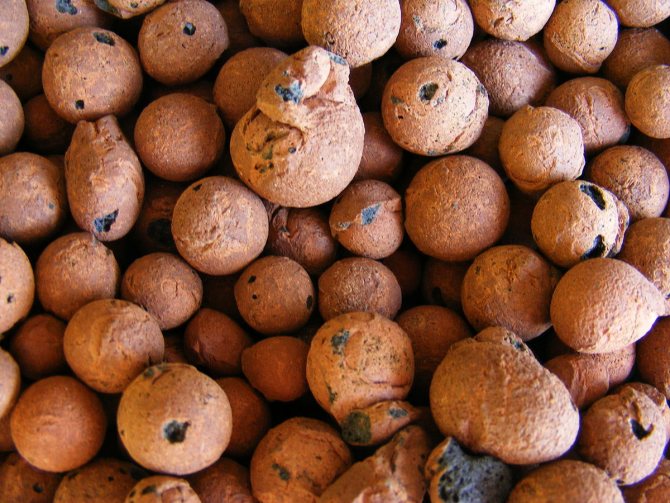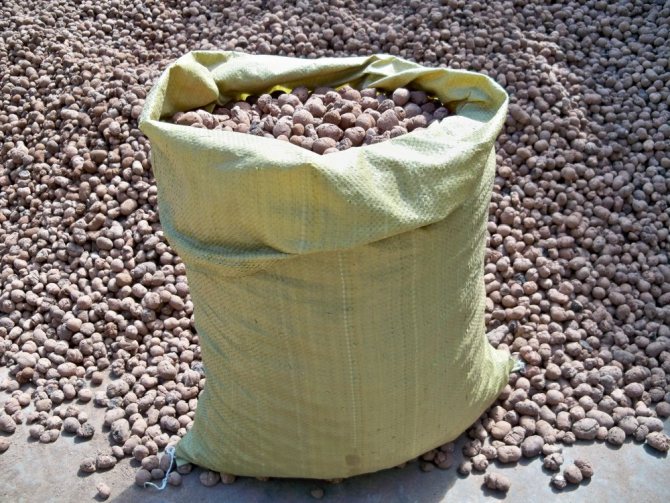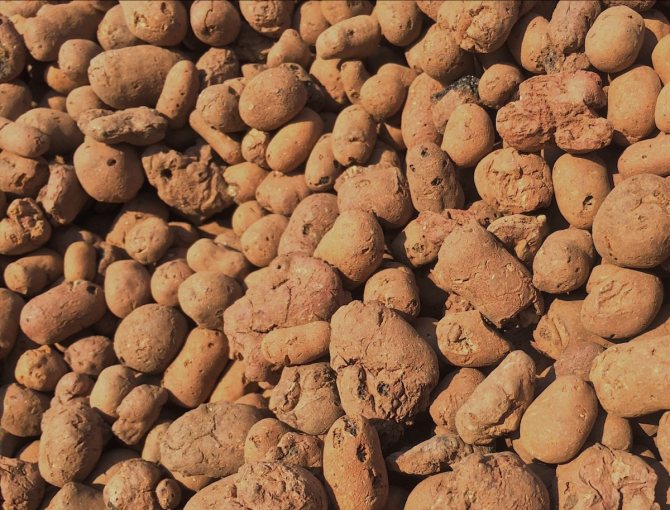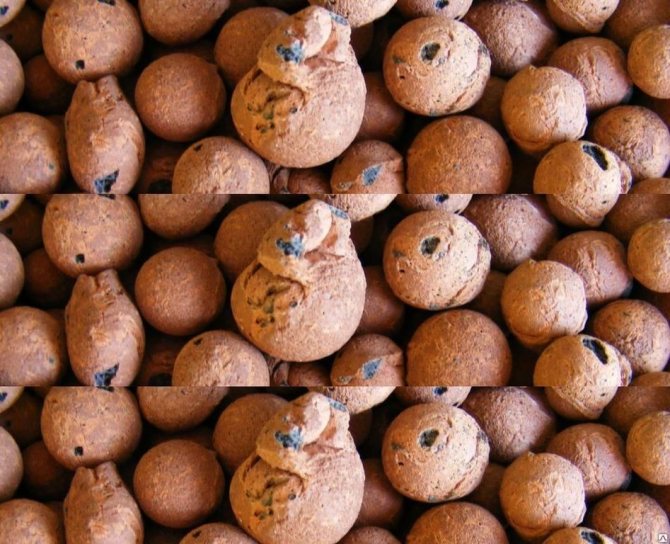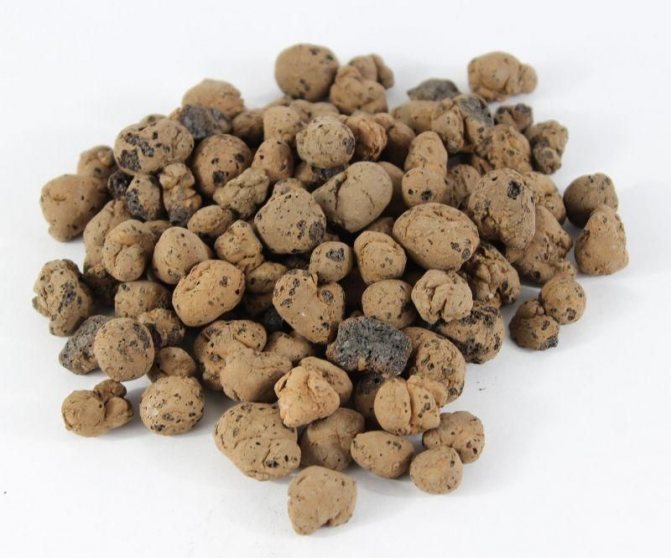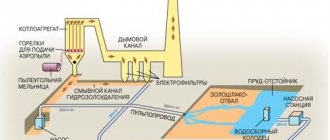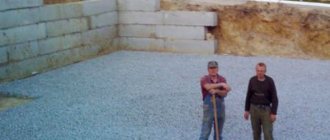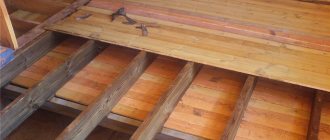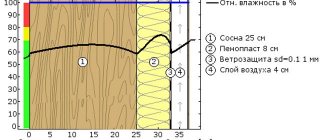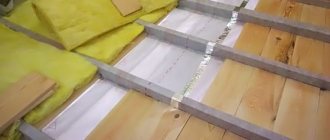Floor insulation technology using expanded clay
Korovin Sergey Dmitrievich
Master of Architecture, graduated from the Samara State University of Architecture and Civil Engineering. 11 years of experience in design and construction.
Anyone with a construction education is familiar with heat engineering. This is a whole science that studies the protection of buildings from the penetration of cold and is based on the laws of physics. With the help of calculations, experts find out the thickness of the insulation, selected from a huge range of modern materials. It is important to protect all structures from the cold: walls, floors, roofs. Warming the floor with expanded clay can be one of the options.
How insulation works and why is it needed
Air is the most effective thermal insulation material. Only inert gases, which practically do not react with the environment, can compete with it. Such gases are used, for example, when filling the chambers of double-glazed windows, but it is impossible to ensure complete tightness in the main building structures.
All thermal insulation materials have a porous structure. It is in the pores that air is retained and prevents heat loss. The lower the density of the material, the better it will perform its function. Insulation can be used roll, plate, spray or bulk. Bulk is one of the most budgetary and easy to do-it-yourself laying, but it also has the lowest heat-shielding characteristics.

The main heat loss at home. Through the floor - 10-15%.
It is necessary to insulate the floors above the basement, on the ground or in the ceiling of a cold attic for the following reasons:
- ensuring a comfortable stay in the house;
- reduced heating costs;
- protection of structures from condensation, which leads to the formation of mold and mildew;
- increasing noise insulation.
If you do not carry out the insulation, serious problems will arise during the operation of the house.
Pros and cons of expanded clay as insulation
In the construction of apartment buildings, the thermal calculations of the building structures, along with the strength calculations, are checked by an examination. In this case, floor insulation with expanded clay is not used, since this material cannot be classified as highly effective. It is most profitable to lay bulk insulation in a private house.
Its advantages include:
- ease of styling with your own hands;
- low cost;
- environmental Safety;
- creating an even base for the floor cake;
- resistance to temperature extremes;
- the possibility of using for floor insulation, which in the future will be subjected to heavy loads, for example, the floors of industrial facilities.
The negative characteristics include the fact that this material has a lower thermal insulation capacity compared to mineral wool and expanded polystyrene.
Before insulating the floor with expanded clay, it is necessary to determine which layer of thickness will be used. Bulk material has twice as much thermal conductivity as mineral wool, so its thickness should be doubled. In most cases, the best option would be 200 mm.
Faction selection
Expanded clay is made from special clay, which swells when heated. It is represented by three factions:
- Expanded clay sand. It is added to dry mixes to improve their thermal insulation characteristics;
- Expanded clay crushed stone. It is a larger particle with sharp edges;
- Expanded clay gravel. It is the best material for insulation in a private house. It has the same size as crushed stone, but in a rounded shape.The pores are protected from the outside by a layer of caked clay.
It is recommended to purchase expanded clay with granules of different sizes, as this will ensure its penetration into all hard-to-reach places.
It is important to ensure that there is a minimum amount of damaged granules in the total volume, in which case the insulation will become most effective.
Application area
There are a lot of options for using the material when insulating floors in the house:
- insulation of floors on the ground under the screed;
- backfilling the space under the boardwalk when arranging floors along the logs;
- insulation of the attic floor.
It is important to remember that in all three cases, the floor cake is quite different. Insulation of the attic with expanded clay depends on the design of the floor, it can be performed both along the logs and under the screed.
Practical advice
To increase the strength of the expanded clay screed, it is recommended to wet it with water twice a day. This must be done carefully, do not fill with water, do not allow dry expanded clay to get wet. Watering significantly improves the physical performance of the screed, the chemical reactions of the cement slurry proceed in a favorable mode. You need to water the screed for two to three days, the exact time depends on the weather. At high temperatures, the number of soaks increases; complete drying of the top layer of the screed must not be allowed.
Moistening the screed with plain water is necessary to make the floor even
If the operating conditions of the building require an increased height of the expanded clay insulation layer, then it can be stacked in bags. Plastic bags increase the stability of the position of the granules, expanded clay does not crumble under the feet of the master, there is no need to use special additional devices and devices. For the final leveling of the surface of the filling, a layer of fine fractions with a thickness of 2-3 cm is added from above. This technology allows 30% less time (MISSING).
We recommend: What windows are better to put in a private house, apartment - we figure it out together
Expanded clay in bags
If possible, do not use expanded clay floor insulation technologies using cement milk. The strength of the base will increase, but the heat saving effect will be significantly reduced. There are many other building techniques for increasing the load-bearing capacity without compromising the thermal performance of the floor.
Expanded clay is spilled with cement milk
Warming with expanded clay is very beneficial to do in outbuildings or garages. Especially if the construction site is uneven and it is impossible to do earthwork for various reasons. Expanded clay will independently even out the differences in the base in height up to ten centimeters, an increase in the amount of material does not have a noticeable effect on the change in the initial estimated cost of the object.
The tangible effect of floor insulation with expanded clay can be achieved with a layer of insulation of at least 15 centimeters. This must be borne in mind when choosing the type of base for the screed. Not all rooms allow flooring due to such a significant reduction in the height of buildings.
The more airtight the top waterproofing, the higher the thermal insulation performance. It increases due to the absence of air convection, waterproofing serves as a reliable obstacle to the movement of warm and cold air masses. The optimal method for the upper waterproofing of the floor screed is ordinary plastic wrap.
Video - Insulation of the floor with expanded clay under the screed
Insulation technology
In order to competently carry out measures to improve the heat-shielding characteristics of the floor with your own hands, it is necessary to follow the order of work. Depending on the type of floor to be insulated in the house, the layers and their arrangement differ.
Floor on the ground
The work is carried out in the following order:
- compaction and leveling of the base;
- adding sand and gravel for additional compaction and leveling;
- laying of waterproofing material (in the case of a high level of groundwater);
- laying and leveling a layer of expanded clay;
- Lean concrete footing device;
- laying of a vapor-waterproofing material, which can be used as an ordinary plastic film;
After performing insulation on the ground, a reinforced cement-sand screed is poured with their own hands, on top of which a clean floor covering is laid.
Insulation of the basement or underground floor
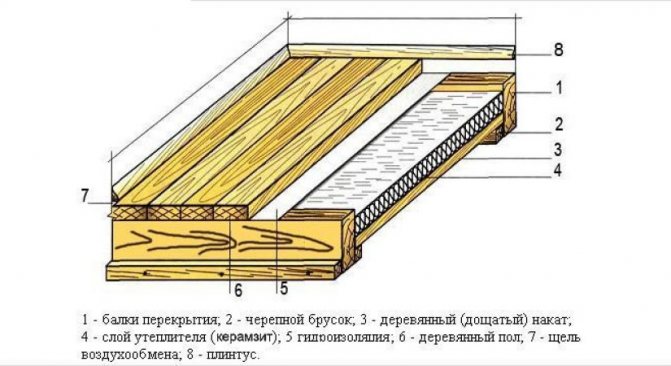

Warming of a wooden floor with expanded clay can be done both on logs and without them. It is necessary to lay each layer in the order presented:
- floor installation;
- laying a layer of waterproofing;
- if necessary - installation and fixing of the lag;
- bulk material is laid;
- leveling expanded clay;
- vapor barrier layer - polyethylene film;
- installation of a clean floor or screed.
It is very important when working with insulation to lay the waterproofing and vapor barrier in the correct order.
Insulation of the attic floor
For the attic, each layer is arranged in a slightly different order:
- floor structure;
- vapor barrier - polyethylene film;
- when laying insulation on logs - installation of wooden bars;
- backfilling of expanded clay;
- waterproofing;
- clean floor or cement screed.
Material properties and advantages
Expanded clay contains exclusively natural components that are not capable of harming health. Its basis is clay, which undergoes thorough cleansing and drying. Upon completion, the crushed mass is placed in a special oven. In it, under the influence of high temperatures, a porous structure is formed.
In addition, expanded clay has a significant amount of other positive qualities, some of which should be definitely noted:
- The material is frost-resistant, due to which it tolerates freezing cycles well.
- Non-flammable. Insulation is one of the non-combustible materials, which, if necessary, are also used to provide fire protection.
- It is not a place for the formation and residence of insects and rodents, it is excellent for use in private homes.
- Expanded clay provides an increase in sound insulation.
- It has negligible thermal conductivity.
- Long period of operation. The laid material can easily serve for the entire life of the building.
- Insulate freely tolerates exposure to a variety of chemicals.
- High level of thermal insulation. A layer of expanded clay 10 cm thick in its characteristics is not inferior to a wood covering, which is three times thicker.
- Availability. Due to its relatively low cost (about $ 2.5 for a 20 kg bag) many people can afford it.
- Ease. Due to the low weight, even when filling a large layer of insulation, there is no need for the construction of special frames and other structures.
Expanded clay is also quite simple to lay and, due to its flowability, it is easy to fill all hard-to-reach areas with it, and when using it, it is not necessary to have special skills, since most of the work carried out with it occurs without significant difficulties even for novice craftsmen.
Features of laying expanded clay
When carrying out activities for the heat protection of the floor with your own hands, it is necessary to take into account the peculiarities of the material used. Carrying out floor insulation with expanded clay, you need to know:
- To obtain a flat surface, beacons are used. The smaller the step of mounting the lighthouses, the more chances you have to perfectly lay expanded clay with your own hands.
- When laying on logs, all wooden elements must be treated with antiseptic compounds.
- The minimum layer of material is 10 cm.
- It is best to install a wooden floor covering when using expanded clay.
- The floor can be used 7 days after the completion of construction or repair work.
Screed laying technology on expanded clay:
Do-it-yourself insulation with expanded clay allows you to carry out work with minimal costs without compromising quality.
Thickness calculation
In all these cases, when filling, the thickness is selected approximately, the layer is taken 15-20 cm. But if necessary, you can carry out a simple calculation. In this case, specialists use the Teremok program. It is very simple and freely available. You can calculate the layer online or offline by installing the software on your computer.
Bulk insulation is available in the database, you just need to find it. For building a house with your own hands, this program will be able to make professional heat engineering calculations for any floor structure: on the ground, on the ground floor, in the attic.
How to calculate?
For floor insulation, a layer of expanded clay 15-20 cm thick is often used. To calculate the amount of material required, use the Teremok program. It helps to automatically perform accurate calculations, taking into account the rules and regulations, and is optimally easy to use. You only need to enter the parameters of the object of work and the material that you will use.


What is expanded clay
Expanded clay is a loose insulation consisting of granules of different sizes. It is made from low-melting types of clay by the fast firing method. The result is a material with a porous surface, which provides good thermal insulation properties. It is highly durable and lightweight. For construction works, expanded clay of three fractions is used, information about them is presented in the table.
| Expanded clay fraction | Density tons / cubic meter m | Weight 1 cub. m |
| Sand fraction 5-10 | 0,45 | 0,45 |
| Gravel fraction 10-20 | 0,4 | 0,4 |
| Crushed stone fraction 20-40 | 0,35 | 0,35 |
The operational properties of all fractions are approximately the same, each is used where it is more convenient. For example, gravel and crushed stone are usually chosen for floor insulation.
Main types of material


For laying "floating" floors, large and small-caliber granules are used
Expanded clay material is divided into three fractions, namely:
- Crushed stone - small stones with sharp corners, which are often used to prepare cement mortars;
- Sand is a fine-grained bulk material, the grain size of which varies from 1 to 5 mm. Sand is used in construction for the preparation of various leveling and heat-insulating mixtures;
- Gravel - coarse material is used to create screeds with good heat and sound insulating properties. Like sand, it is added to cement mortars.
What kind of expanded clay is used for the installation of a dry screed? Despite the fact that the heat-insulating material can be different, coarse and small-caliber granules are used for laying "floating" floors.
Methods for insulating the floor with expanded clay
One of three possible methods can be chosen for arranging thermal insulation of floors. Let's consider each of them in more detail.
Dry laying of expanded clay
The fastest and least time consuming option. It involves backfilling expanded clay on the base under the subfloor. The insulation can be laid loose throughout the room, but in this case it will be quite difficult to align it. Therefore, logs or beacons are installed on the base and expanded clay is poured between them. A sub-floor is laid on top of the insulator layer, which must be at least 10 cm. The finishing coat is already being mounted on it.
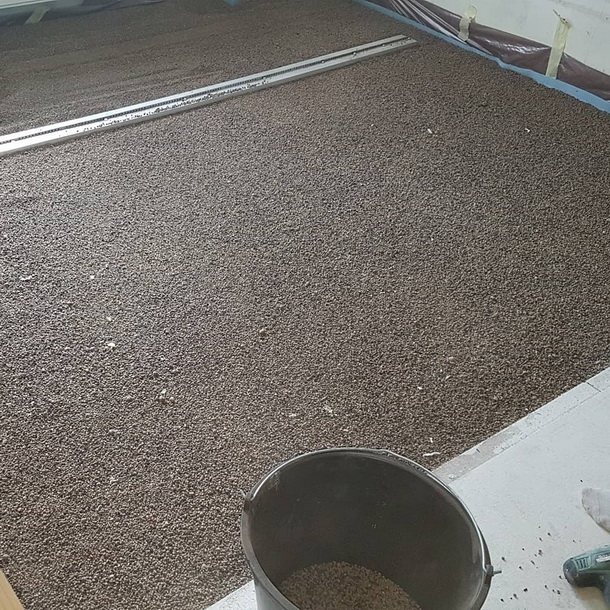

Photo: Instagram brigadaspb
Stages of work:
- Preparing the base. If necessary, we dismantle the old floor covering. We clean, remove debris and dust. We close up large defects and cracks, joints between the walls and the floor.
- Install lags. If the old ones have survived, we carefully inspect them, remove the unusable ones. We set the beams exactly at the level, so that their upper edges form a flat surface.
- We install waterproofing.We lay the membrane or ordinary polyethylene in such a way that they cover the logs. We overlap the resulting joints and glue with special tape. We fix the material on the logs with a stapler.
- We mix expanded clay of two fractions to make the coating more dense. We fill up the space between the lags with the resulting mixture. We tamp the granules and level the backfill layer.
- We lay the top layer of waterproofing, attach it to the logs.
Now you can lay the subfloor and proceed with the installation of any topcoat.


Photo: Instagram sk_tehnologiya
Wet laying of expanded clay
It involves mixing expanded clay with liquid concrete. The resulting mixture is placed on beacons similar to a conventional screed. This method is especially good for foundations with significant elevation differences. The main disadvantage is a decrease in the insulating properties of expanded clay in concrete.
Stages of work:
- We prepare the base, freeing it from debris and dust. We repair defects if necessary.
- We set beacons strictly according to the level. The operation is carried out in the same way as when laying a conventional leveling screed.
- Mix in portions expanded clay with a cement-sand mixture. There are no exact proportions, approximately 1 part of the filler is taken for 2 parts of the solution. The main criterion is that all granules must be wetted with liquid concrete.
- We spread the resulting mixture between the beacons using a trowel. We immediately level the upper part with a long rule.
The expanded clay concrete screed will dry out in two days, but it will be possible to lay the topcoat on it not earlier than in a month.
Combined method of warming with expanded clay
The insulation is poured between the logs and leveled. Then the top layer of the material is fixed by spilling it with cement mortar. The concrete screed is poured after the prepared base is completely dry. The advantage of this method is the preservation of the insulating properties of expanded clay. The material can be laid directly on the ground, for example in a country house, or on a concrete base.
Stages of work:
- Preparing the base. We carry out, if required, dismantle the old coating, remove debris, seal up defects and cracks.
- We lay the waterproofing under the insulation. This can be a membrane or a film or liquid insulation layer. In any case, the material should cover not only the floor, but also the lower part of the walls like a "box". After that, at the level of the future screed, we fix the damper tape.
- We expose metal beacons. Aluminum T-bars are ideal. We put them strictly according to the level, fixing them to the solution.
- We mix expanded clay of two fractions for better filling density. We fill the space between the beacons with this mixture, paying special attention to the joints and corners. Gently ram the granules, maximally compacting the insulation layer.
- We carry out reinforcement. We lay a coarse-mesh metal mesh over the expanded clay. It should be free of dents and sharp edges.
- We lay the screed directly on top of the expanded clay. We apply a sand-cement mixture, level it with a long rule.
After the mortar has completely dried, it will be possible to lay the topcoat.
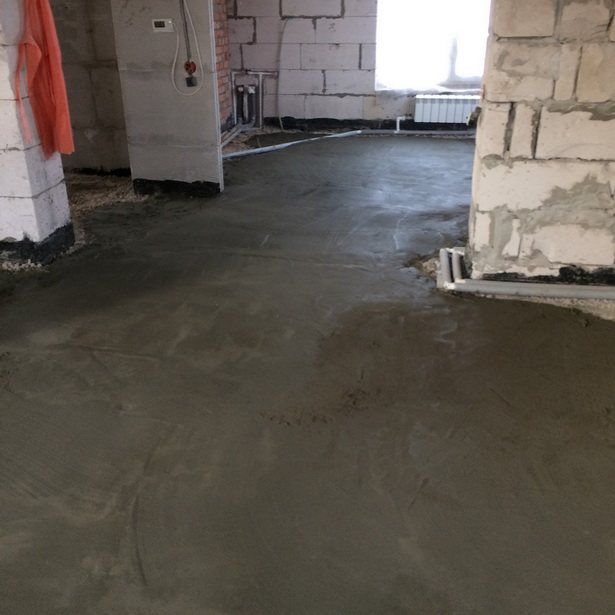

Photo: Instagram pravremont.ru
The use of any of the described methods of floor insulation with expanded clay, provided that it is performed correctly, guarantees effective protection from the cold.
- Prepared by: Inna Yasinovskaya
No comments yet. Start a discussion!
IVD. 2-room apartments
Found a bug? Select it and press Ctrl + Enter
The IVD.ru website is a leading Internet project dedicated to the reconstruction and interior design of residential premises. The main content of the site is the archive of the Ideas for Your Home magazine - exclusive author's articles, high-quality illustrations, practical advice and lessons.A team of professionals is working on the project in close cooperation with renowned designers, architects and leading experts of the publishing house.
On our site you can find complex design solutions; view detailed reviews of the market for building and finishing materials, furniture, machinery and equipment; compare your own ideas with the design projects of leading architects; communicate directly with other readers and editors on the forum.
Recommendations when using expanded clay
Nuances that you need to know when insulating a floor with expanded clay with your own hands:
If the priority is the heat-saving effect, then dry expanded clay is used. A dry pillow keeps you warm better. The technology for performing the dry method depends on which layer of expanded clay for floor insulation is sufficient in specific conditions. If the thickness of the pillow is large (more than 10 cm), then it is worth pouring two layers, separating them with sheets of gypsum board. plywood, etc. This design will provide stability to the coating. To fix the beacons, gypsum or alabaster can be added to the solution - this will speed up the setting and allow you to start filling expanded clay immediately after setting the guides. The use of granules of different sizes provides better adhesion and, accordingly, greater strength. Reinforcement with a metal mesh of the expanded clay layer increases the reliability and strength of the structure. The expanded clay-concrete screed reaches its final strength in 4 weeks, so you should not expose it to excessive loads immediately, despite the fact that it solidifies literally on the second day.
Warming a wooden floor with expanded clay or leveling a concrete base in an apartment with your own hands will save money. They can be used on an expensive decorative coating, which will become an interior decoration and a great backdrop for home photos and videos.
4
Performing work on a concrete base
Before proceeding with the insulation, you should prepare all the necessary tools and materials. These include: building level, jigsaw, marker, drill, hammer, screws, sand, expanded clay, waterproofing materials.
4.1
Dismantling the old coating
The floorboards are dismantled and removed from the room to free up space. It is advisable to inspect the logs, check their evenness using a building level. If the bars are in good condition, without deformations, deflections, they are left in their place. In case of damage, it is advisable to replace individual logs.
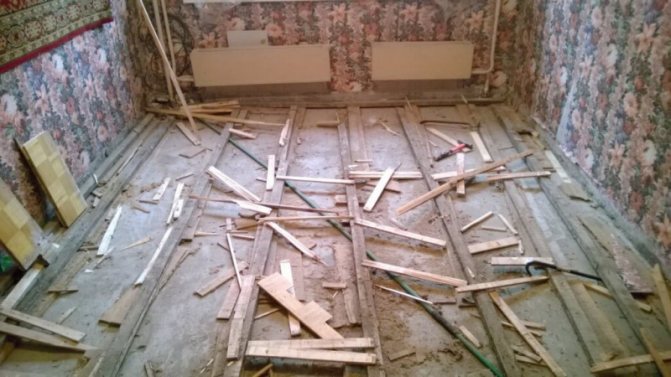

4.2
Training
The surface is cleaned of debris, small potholes are rubbed or blown out with foam. All existing joints should be processed.
When the composition dries, the base is covered with a small layer of sand, it is carefully tamped. When using a coating waterproofing, you can not use sand.
4.3
Waterproofing
Spread polyethylene along the base. It is important to carry out the work so that the edges of the material cover the walls by about 10 cm (the film should hide the lags). If there is no single large piece, the parts of the product are overlapped, fastened to construction tape.
Waterproofing on the logs is fixed with a stapler.
In the case of using a coating material, the base is treated with the selected mixture (it must be cleaned of dust) using a roller. The walls should also be hooked up to a height of 20 cm. In this case, the joists are mounted on top of the protective compound. Liquid rubber, bitumen or cement-polymer mastic is suitable for coating.
The composition is applied in at least two layers, each of which dries within three hours. At the end of drying, a damper tape is installed around the perimeter of the room. This material will minimize the risk of cracks in the screed in the event of temperature fluctuations.


4.4
Installation of rails
If the lags have been removed completely, new ones are installed using a high-quality timber. The material is cut to size, treated with an antiseptic, and dried. Height - at least 10 cm.The extreme products are mounted at a distance of about 3 cm from the surface of the walls, the gap between the rest should be about 1 m. When performing work, be sure to use a building level.
The products are attached to the floor on metal corners.
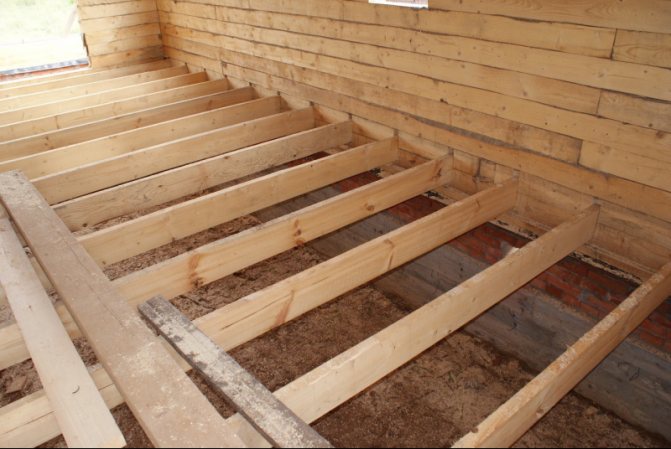

4.5
Backfill of expanded clay
Gravel is kneaded in the container, it is poured between the slats. The mixture is carefully distributed in the corners, which will avoid the appearance of voids. Having filled all the space, the layers are tamped, a waterproofing film is laid on top, securing it with a stapler.
4.6
Coating installation
A rough covering is mounted on the logs. The film is cut off, and the joints between the wall and the material are covered with skirting boards.
If instead of a concrete base there is soil, the work will look a little different:
the surface is leveled, carefully rammed; a claydite substrate 10-15 cm thick is poured; a layer of sand is poured, compacted; a layer of loose material about 25 cm thick is again poured; level, compacted, and the floor is installed.


Expanded clay as floor insulation: pros and cons
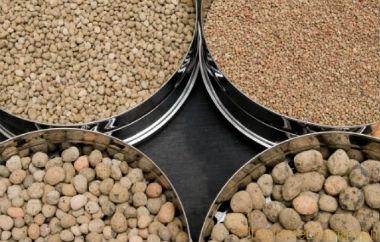

Expanded clay fractions are different (from sand to crushed stone).
The technique of floor insulation with expanded clay in a wooden house, as well as under a screed on a concrete floor, has been used for a long time. It cannot be said that this is the most effective heat-insulating material, since its characteristics are rather modest:
- lambda thermal conductivity 0.1-0.18 W / m * K;
- water absorption 8-10%;
- density up to 500 kg / m. cube;
- does not burn;
- does not contain any harmful substances, all natural.
Despite this, expanded clay as a floor insulation is a perfectly acceptable alternative, given its low price. This is foamed and baked clay, which comes in different fractions: from sand to crushed stone. Compressive strength depends on the density of the material, the higher the density, the stronger the material. For insulation of the floor with expanded clay, according to reviews, thermal insulation of the middle fraction (balls with a diameter of about 1 cm) is most suitable. Despite the low degree of moisture absorption, this material, although slowly, saturates water, after which it does not remove it. It is difficult to dry expanded clay, this process takes a very long time. During installation, dust may appear - these are small chipped particles of baked clay.
Today, gas heating of a private house is cheaper than any other energy source.
Read more about gas heating in the apartment (reviews and opinions) here.
Preparation is an important step
Preparation of the base for backfilling with expanded clay begins with cleaning the surface. A clean base is evaluated for curvature and flatness differences. This is done in order to see what layer of expanded clay is needed for floor insulation, leveling the surface and calculating the required amount of material.
The optimal layer thickness is 80 - 100 mm, to determine the required amount of granules, a mark is made on the wall to a height of 8 cm at the highest point of the room, from which a horizontal line is then marked with a level along the perimeter of the room.
The average value of the backfill height is obtained by measuring the distance to the horizontal line in several places, which is then divided by the number of measurements. So, if three measurements were made with values of 10, 15, 8 cm, then the average height of the backfill will be (10 + 15 + 8): 3 = 11 cm.Then the area of the room (width x length) is multiplied by the height (average value) obtained the figure indicates how much expanded clay is needed to insulate the floor of this room.
Attention: practitioners recommend purchasing material by 10%! B (MISSING) more than the calculated figure in order to protect yourself from the need to interrupt work due to an error in calculations and a lack of a handful of insulation.
The actual preparation is reduced to the following actions:
We recommend: Concrete staircase (monolithic) - how to make it yourself?
Sealing cracks, potholes with mortar (for concrete floors). Base waterproofing.For this, any available technologies and materials are used: special mastic, preparation of a waterproofing solution from polymer dry mixtures. If the floor is insulated with expanded clay on the ground, then the best solution would be a plastic film (not thinner than 100 microns) or roll material (roofing felt).
Thermal insulation of wooden floor with expanded clay
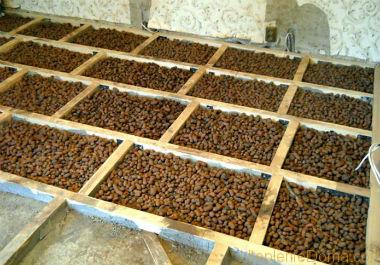

The method of laying expanded clay on the logs (do not forget to lay the waterproofing).
Thermal insulation of the floor with expanded clay in a private house is preceded by the calculation of the required thickness of the thermal insulation cake. At the same time, it will not work to fill in more material than the distance between the rough and final floor. If this distance is not enough, you need to choose another insulation, or somehow increase the buffer zone.
Before insulating the floor with expanded clay, you need to lay waterproofing on the subfloor - this is a diffusion membrane that allows air and steam to pass through only in one direction. The membrane should be placed with the advertisement facing down and the rough side facing the thermal insulation. Laying is carried out with an overlap, there is a special line on the rolls, then all joints are glued. The main task is to prevent moisture from the ground from getting into the thermal insulation layer.
In addition, the insulation must be protected from steam that comes from the room. This is especially true when insulating the floor in a bath with expanded clay. For protection, a vapor barrier film is used - it is a polymer material or reflective insulation that does not allow steam and water to pass through, and foil materials also emit infrared radiation. Therefore, reflective insulation must be installed with the mirror side inward. The vapor barrier is completely sealed. Bottom layers:
- rough floor;
- diffusion membrane;
- expanded clay;
- vapor barrier;
- air gap (desirable);
- clean floor.
In addition to protecting the insulation from moisture, films have another function. Thanks to them, a layer is created in which the air is in a state of relative rest, that is, it does not move. This somewhat reduces the coefficient of thermal conductivity of the enclosing structure, since air (more precisely, vacuum) is the best insulation. Naturally, there is no question of any vacuum in the heat-insulating cake, but, nevertheless, the absence of convection has a positive effect on the quality of insulation.
Having installed a smart home system, heating and all appliances powered by electricity can be controlled from a smartphone.
Read here why a two-pipe heating system of a cottage is better than a one-pipe heating system.
How to make a dry screed?
This technology is the most popular today. An ordinary "wet" screed means preparing a solution, leveling it, etc. A "dry" screed does not need to be poured, cooked, leveled, wait several days (or even weeks) until solidification occurs. The simplicity of the technology is off the charts, it can be used to insulate the floor with expanded clay in a wooden house. In this case, the thickness of the insulation layer should be approximately 20-30 cm. Only in this case it will be possible to achieve maximum efficiency.
The technology is about the same as laying boards on logs. But not boards are mounted, but special gypsum-based plates. The advantage of this kind of technology is that it is simple. But you also get a perfectly flat floor, smooth, ready for finishing. And if necessary, this coating is very easy to dismantle. And if you make a "wet" screed, you will have to break it to dismantle it. This technology can be used both when insulating the floor with expanded clay in a wooden house, and in an apartment.
Sources:
- https://derevyannie-doma.com/tehnologii/uteplenie-pola-keramzitom-v-derevyannom-dome-mezhdu-lagami.html
- https://pol-spec.ru/styazhka-pola/uteplenie-pola-keramzitom-pod-styazhku-dostoinstva-podrobnoe-opisanie-metodiki-sekrety-pravilnogo-vypolneniya-rabot.html
- https://stroyday.ru/remont-kvartiry/pol/uteplenie-pola-keramzitom.html
- https://polspec.com/teplyy-pol/kak-uteplit-pol-keramzitom-varianty-utepleniya.html
- https://obustroen.ru/stroitelystvo/uteplenie-pomescheniy/uteplenie-pola-keramzitom.html
- https://dekoriko.ru/pol/uteplenie/keramzitom/
- https://fb.ru/article/408746/uteplenie-pola-keramzitom-v-derevyannom-dome-preimuschestva-i-nedostatki-tehnologiya-i-sovetyi-masterov
Warming with expanded clay under the screed
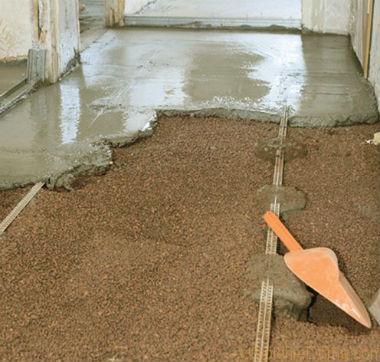

It is necessary to level the expanded clay layer along the beacons for the screed.
Insulation of the floor with expanded clay under the screed can significantly save money, since the modern material that is used for these purposes is expensive. They also read: "Is it worth it to insulate a wooden house with Penoplex". The screed is poured both on a concrete base and directly on the ground. Naturally, floor insulation with expanded clay on the ground is typical for private houses or outbuildings. In apartments, thermal insulation is laid on a concrete base. Let's start with him.
The thickness of expanded clay for floor insulation in an apartment rarely exceeds 5 cm. Of course, the heat-insulating and sound-insulating characteristics of this material are clearly inferior to polymers. Let's make a small calculation, the thermal resistance coefficient of a five-centimeter layer of expanded clay will be 0.5 (thickness in meters, divided by thermal conductivity lambda). For comparison, for EPS with the same thickness, the coefficient will be 1.56.
Do not confuse the thermal resistance coefficient of the building envelope with the thermal conductivity coefficient. In the first case, the higher the value, the better the structure retains heat, and in the second case, the higher the value, the better the material conducts heat.
The technique of floor insulation in the apartment with expanded clay under the screed:
- a damper tape is glued around the perimeter;
- polyethylene film is laid;
- expanded clay is poured, then leveled;
- beacons are installed and the screed is poured.
It couldn't be easier. Expanded clay as a floor insulation under the screed on the ground is also used everywhere. First, the soil must be leveled and covered with a layer of sand. The sand is well rammed, roofing material or bitumen roll waterproofing is laid on top of it with launching on the walls at the height of the screed. Damping tape is glued around the perimeter of the room. Expanded clay (10-15 cm) is poured onto the waterproofing and concrete is poured. The method is also quite simple.
When to choose expanded clay
The range of heat-insulating materials on the modern market is so large that it is difficult to stop at any one. However, it is worth learning the whole range of properties of this unique material in order to understand that there is no better option than to insulate the floor with expanded clay.
The list of properties due to which this simple material is leading among competitors:
- Low thermal conductivity - the porous material contains air bubbles, which provide high-quality thermal insulation. A layer of expanded clay 10 cm surpasses a similar wooden surface in terms of thermal conductivity by 3 times, and brickwork by 10 times.
- Sound insulation - the property is in demand in apartments in multi-storey buildings, the expanded clay floor will serve as a reliable obstacle to the penetration of noise from neighbors below, at the same time preventing the propagation of sounds in the opposite direction.
- The strength of the material allows it to be used in the lower layer of the floor cake without additional supporting structures (expanded clay is produced in different strength grades from 250 to 600).
- Resistance to decay and fungi, mold (as opposed to wood-based materials) increases the service life of the floor, its durability.
- Chemical inertness - expanded clay is a natural material that does not emit any substances into the environment, and is also resistant to chemicals itself.
- Heat resistance - quality is relevant in terms of fire safety.
- Frost resistance - expanded clay does not lose its properties at extremely low temperatures.
- Light weight - allows you to insulate the floor with expanded clay under the screed in houses where a large load on the floors is undesirable (read: "We make the floor insulated under the screed - practical advice").
- The granular fraction of the material ensures the convenience of working with it - one person who does not have construction skills can handle the filling.
- Low cost is an additional bonus for a material with a set of excellent qualities.
READ MORE: Self-leveling floor leveler which is better
The only drawback of expanded clay is its ability to keep moisture for a long time. This disadvantage can be easily leveled, observing the technology of flooring with expanded clay, carefully gluing the waterproofing layer.
The price range of materials in this category is as wide as their variety:
- Bituminous mastics;
- Polymer mixtures;
- Rubber hydro-barriers;
- Polyethylene film;
- Roll materials of various compositions.
How to insulate the floor in a wooden house with expanded clay
Wooden construction is mainly country houses. Moreover, both new buildings and those that were built long ago as summer cottages. Today these buildings are increasingly used for year-round living. Therefore, the issue of warming all parts of the house becomes urgent.
The floor in wooden buildings is one of the coldest parts of the whole structure. According to various estimates, up to 20% of the internal heat in rooms is emitted through the floors in wooden houses. It makes sense not only to design good insulation when building a new house, but also to take care of reworking the floor in an already built one, but without floor insulation. Moreover, usually a residential wooden house is installed on a relatively high foundation. And this allows insulation from below without changing the level of the finished floor and without reducing the height of the room.
When erecting ancillary wooden buildings, the floors can be located close to the ground or even be laid directly on the ground. In this case, the insulating layer is still necessary, only it will have to be laid, burying it into the ground.
Any insulation of wooden floors must be carried out in compliance with the following rules:
- Compulsory laying of waterproofing in two layers. The bottom layer protects the insulation from moisture from the ground. The top layer - from water penetration through the boards of the finished floor.
- Rough and fine wooden floor elements are treated with special anti-rotting agents.
- For insulation, a material is selected that does not change its properties upon contact with wood.
Despite the recent appearance of modern insulation materials, expanded clay insulation of a wooden floor is still used. And there are reasons for this.
Expanded clay: pros and cons
Insulating expanded clay - granules made by foaming and subsequent clay firing.
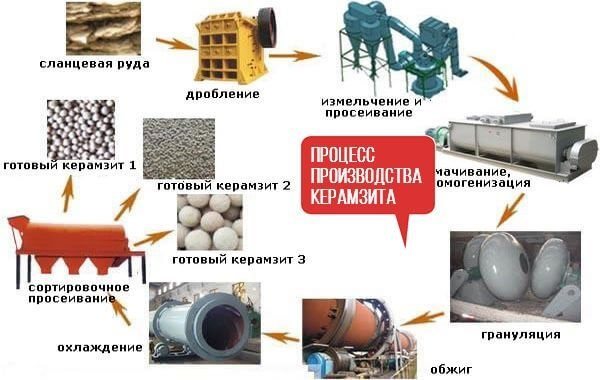

Scheme of production of expanded clay granules
It has a number of advantages when used as thermal insulation.
- Low thermal conductivity. The clay itself, from which it is made, is considered a good heat insulator. And the pores created inside, filled with air, further reduce the thermal conductivity. As a heat insulator, it is several times more effective than clay bricks and twice as good as wood.
- Light weight. An increase in the thickness of the expanded clay layer does not lead to a significant load on the floors.
- Cheapness. Despite the fact that it is inferior in thermal conductivity to many modern materials, its use saves money, losing insignificantly in the quality of insulation.
- Fire safety. This material not only does not burn, but even does not emit any toxic substances under strong heating.
- Resistant to temperature extremes. Thermal insulation properties do not change in heat or frost.
- Resistant to household chemicals and moisture. Even when wet, mold does not form on it.
- Complete environmental friendliness. Made from natural material, it is not completely harmless.
- In addition to thermal insulation properties, it is also a good sound insulator.
- Convenient to use. To work with it, no special skills are required, and no special tools and devices are required. The fact that expanded clay is a bulk material excludes any requirements for observing exact dimensions when laying.
- Long term of use.It is believed to retain its properties for decades.
disadvantages
Expanded clay also has disadvantages. But their list is incomparable with the merits:
- Large volume of heat-insulating layer. To create high-quality thermal insulation, the thickness of the expanded clay cushion should be at least 10 cm. But in practice, the expanded clay layer is usually 20 - 30 cm, rarely 40 cm. In some structures of wooden floors, such insulation leads to a decrease in the space between the floor and the ceiling.
- Low moisture resistance. When a large amount of water gets on it, it absorbs it. This leads to an increase in the weight of the thermal insulation. Over time, moisture will evaporate from expanded clay granules, but this is a long process.
- Laying expanded clay, for all its simplicity, is a tedious task. Filling a thick layer, leveling with the obligatory accuracy, so as not to destroy the shell of the granules - all this takes a lot of time.
Varieties of expanded clay
The quality of expanded clay as a heater also depends on the options for its production. Depending on the size, there are three main groups of expanded clay granules. And although there are recommendations for each group for its use, usually a mixture of granules of different sizes is used in one layer.


Expanded clay fractions
- Crushed stone - granules with a diameter of 20 to 40 mm. Recommended for backfilling the main layer of thermal insulation.
- Gravel - 10 to 20 mm. It is used to create thin layers.
- Sand - the smallest granules with a diameter of 5 - 10 mm. Suitable for insulating small voids in floor structures. Mixed with coarse fractions, it can be used to fill the gaps between the granules. It is used to create a "wet" concrete heat-insulating screed.
In addition to size, expanded clay insulation varies in density. Commercially produced expanded clay is divided into several categories with a density of 200 to 800 kg / m3.
The main qualities of the material
- Durability at a high level.
- It is "deaf" to fire, since it is refractory.
- Not prone to mold and mildew formation.
- It serves for a long time, while being environmentally friendly.
Thanks to the selected manufacturing technology, expanded clay granules absorb air into their pores. This explains the so-called bulk density and excellent thermal insulation. Thus, expanded clay is warmer and lighter than concrete and has a density of ten different types.
How widely expanded clay can be used in business strongly depends on the size of its granules. Hence, three fractional groups appear, that is, sand (the smallest granules), crushed stone and gravel. Of course, these parameters allow for a certain error in production, but no more than 5%, and the entire batch.
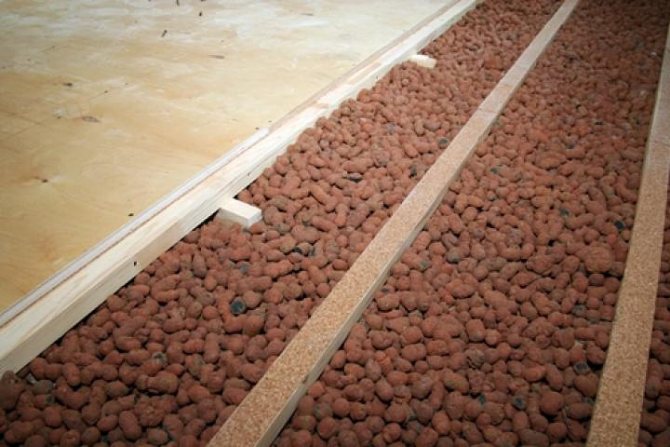

Strength is also a "fat" plus, and for construction it is generally one of the most important indicators. As for heat protection, the expanded clay has something to be proud of: if we compare polystyrene with it, then a layer of the latter (expanded clay) with a thickness of 25 cm corresponds to the thickness of the first (polystyrene) - 18 cm.
So everything testifies in favor of using this insulation as a base for a concrete screed. You can add foam crumbs to it, or you can combine granules of different sizes to create an insulating layer.
Expanded clay is a high-quality bulk insulation in the form of oval and round small stones, made by firing from clay with an admixture of shale rocks. Expanded clay is produced in high-temperature furnaces, inside of which there is a constant intensive movement of fractions of the future insulation material.
One of the distinctive features of expanded clay is the volumetric weight (density) of the insulation material, which per 1 m3, depending on the fractions, is only 200 to 400 kg.
Heat-insulating fractions fired at high temperatures are divided into three main types according to their size.
| Varieties | Specifications |
| expanded clay sand | the fraction has a minimum size of 5 mm, and a maximum size of 10 mm; |
| expanded clay crushed stone | the size of one fraction is increased to a minimum of 5 mm and a maximum of 20 mm; |
| expanded clay gravel | here the minimum material parameters are 20 mm, and the maximum ones are about 40 mm. |
Although in this regard, this bulk substance is still inferior to mineral wool insulation and foam, a characteristic feature is the high thermal conductivity of expanded clay, which is much more effective than brick or wood.
A characteristic feature of this natural bulk substance is a number of advantages inherent in expanded clay, which are reflected in the process of using this heat-insulating material. The substance is characterized by such positive properties as:
- ease;
- strength;
- high degree of heat and sound insulation;
- incombustibility;
- frost resistance of any types of fractions;
- indifference to an aggressive environment;
- ecological cleanliness;
- durability;
- low price and availability for the consumer.
https://youtu.be/EBK0U70UIN0
The disadvantage of expanded clay when insulating floors is its poor moisture resistance, and therefore there is a need for additional use of waterproofing substances. You also need a fairly voluminous layer of this material to achieve efficiency in the process of keeping heat in the room. Thermal insulation of the floor implies filling the space with expanded clay with a thickness of 15 to 30 cm, while a sheet thickness of 5–10 cm is sufficient to insulate the walls with foam plastic.
Expanded clay is an irreplaceable building material in the country. It can be successfully used when arranging a drainage system, laying paths in the garden and when designing a landscape on a site. But its main purpose is to use it as a material for thermal insulation.
Its granules have a porous texture and can be divided by size into 3 varieties:
- Small - has dimensions of 5-10 millimeters and is most often used as the main component for creating expanded clay blocks. In the production of construction work, it is used to form a floor screed.
- The average size is 10-20 millimeters. It is used as a heat insulator for floors and interfloor ceilings in individual housing construction.
- The largest granules have dimensions of 20-40 millimeters and are used for thermal insulation of floors in basements and garages.

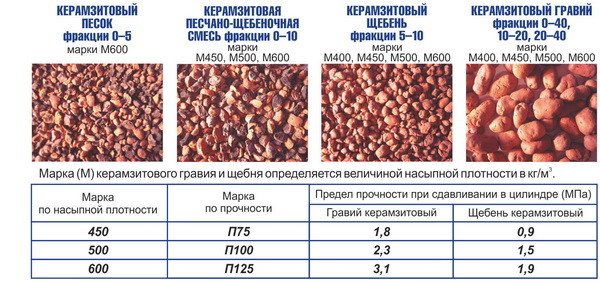
Varieties are also classified according to their structure and shape:
- Expanded clay gravel - fragments are distinguished by the presence of a large number of pores and have a rounded shape. The average granule size is 5 to 40 millimeters in diameter.
- Expanded clay sand. The diameter of the material granules is no more than 5 millimeters. It is a by-product of gravel processing. It is often used as a filler for cement mortars when creating lightweight concrete.
- Crushed clay from expanded clay. In terms of dimensions, the material is similar to gravel, but differs from it in that the fragments have sharp corners, and there are also potholes and chips. It is obtained by crushing large gravel granules. Used as fillers in the production of lightweight concrete.
Methods for creating heat-insulating layers of expanded clay
In general, the construction of expanded clay insulation differs little from the use of other materials. Expanded clay is located under the finished floor with the use of moisture-proof materials.
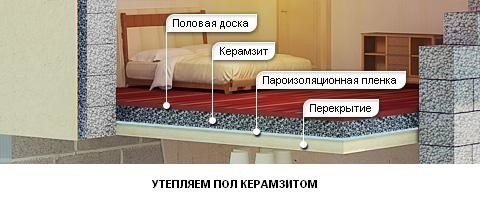

Warming with expanded clay, general principle
Depending on the location of the insulated floor (on logs laid on a foundation, on the ground or on a concrete base), the technology by which expanded clay is laid under a wooden floor also differs.
Backfill between lags
This is the easiest way to lay an expanded clay cushion. In this case, wooden logs serve as the basis for the floor.If they are on the foundation, then shields or sub-floor boards are attached to them. They can be hammered to the logs from below or attached to bars nailed to the logs from the side. The use of lightweight expanded clay is an advantage - the load on the subfloor is low.
Further actions are as follows:
- The logs themselves and sub-floor boards are recommended to be treated with anti-rotting agents. This is especially necessary when creating new insulation in a long-built house.
- The space between the lags is lined with a waterproofing film. As its substitute, you can choose polyethylene or roofing felt. If transverse bars are installed between the lags, then each cell is covered separately.
- Expanded clay granules are poured into the prepared intervals between the logs. It is recommended to mix coarse and fine fractions of expanded clay for full volume filling.
- After backfilling, the expanded clay layer is leveled along the upper edges of the log. Lags act not only as a support, but also as an indicator of the level of the insulation backfill.
- It is advisable to tamp the leveled layer of expanded clay lightly. When tamping, you must not damage the granules, since they will absorb moisture through the cracks.
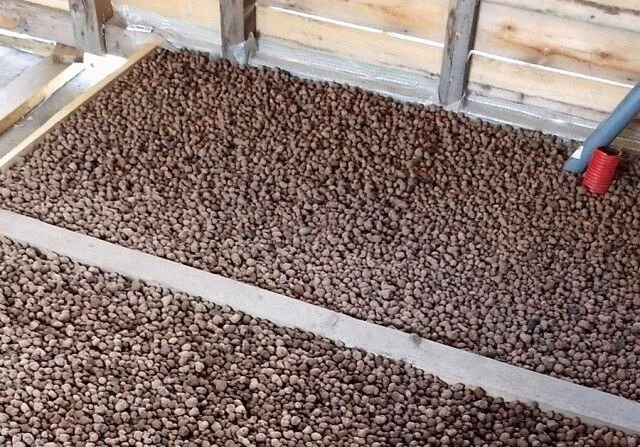

Expanded clay, covered on a wooden sub-floor along the logs
The installation of the floor along the logs can also be carried out on a concrete base as a sub-floor. The expanded clay backfill technology in this case is no different.


Backfilling of expanded clay on logs on a concrete base
Backfill of expanded clay for a wooden floor on the ground
Such floors can be installed in utility rooms or garages. But the expanded clay pillow is not laid out directly on the ground. The procedure is as follows:
- The top layer of the earth is removed.
- A layer of gravel is filled up. It will perform the function of waterproofing, protecting expanded clay from moisture from the ground.
- The gravel is covered with sand, which must be carefully tamped.
- A protective film is laid over the sand.
- The insulating layer of expanded clay is poured onto a sand cushion, leveled and lightly rammed.
- Further flooring depends on the wishes of the builder. You can lay the floor directly on top of expanded clay, you can fill the expanded clay layer with concrete, forming a "wet" screed. And you can use a layer of expanded clay as a rough insulation, creating another insulating level above it, on top of which to lay a finishing floor.
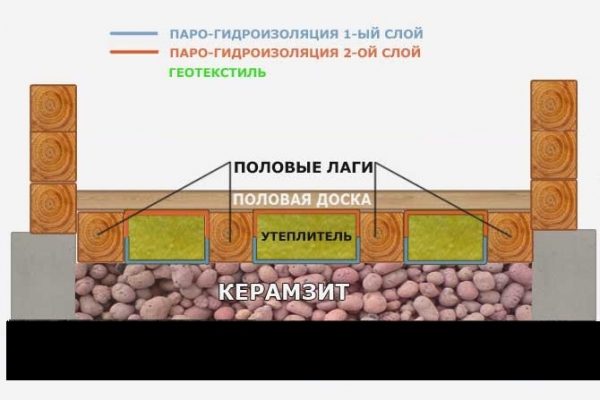

Expanded clay bedding as a subfloor on the ground
Concrete screed using expanded clay
If a concrete base is supposed to be installed under floorboards, then such a floor can be insulated by "embedding" expanded clay into a concrete screed:
- The base prepared for the screed is closed with waterproofing.
- The entire surface is covered with expanded clay. Small fractions are predominantly used.
- The expanded clay layer is leveled and compacted.
- For greater reliability, a reinforcing mesh is placed on top of the expanded clay.
- The last stage is concrete pouring.


Concrete screed on expanded clay pad
Dry expanded clay screed
This method of flooring has recently become known. The preparatory part depends on the base on which it is planned to arrange the screed - on the ground, on a rough wooden floor or on a concrete slab.
The base is covered with a protective film on which expanded clay is poured. After leveling the expanded clay cushion, it is covered with sheets of plywood or gypsum fiber. Fastening sheets - with glue, or self-tapping screws.


Dry screed with insulation
Final work
Any version of the device of expanded clay insulating layer means the completion of the rough stage of flooring. The insulating layer must be covered with a hydro or vapor barrier material. And already on top of this insulation made of plywood or other sheet material, a substrate is fixed, corresponding to the selected floor covering.
With the option of a floor on logs, a wooden finishing floor can be installed directly on them, without creating a separate substrate.


Section of a wooden floor with expanded clay insulation
The order of work
When insulating a wooden floor on logs, proceed as follows:
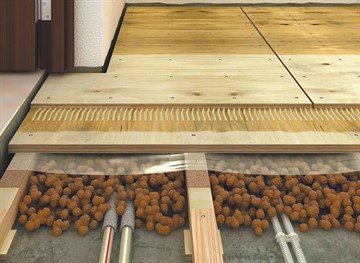

- a mixture of expanded clay of different fractions is poured onto the rough floor between the logs;
- level it so that the expanded clay layer is 1 cm below the surface of the log. This gap is needed to ventilate the wooden floor. It is important to fill all corners with expanded clay, helping with your hands so that there are no voids left;
- carefully tamp the material, avoiding damage to the granules;
- cover the insulation with a foil-coated waterproofing film with a slight approach to the walls;
- floor boards are laid;
- trim the edges of the waterproofing that protrude onto the walls;
- install skirting boards.
Combined insulation is more effective: about 10 cm of expanded clay is poured onto the subfloor (depending on the height of the log and shelves under the preparatory base), and granular polystyrene foam is laid on top. If you foam the seams between the foam and the logs, no waterproofing is required. In this version, expanded clay acts as a protection from mice - it does not allow them to get to the foam.
